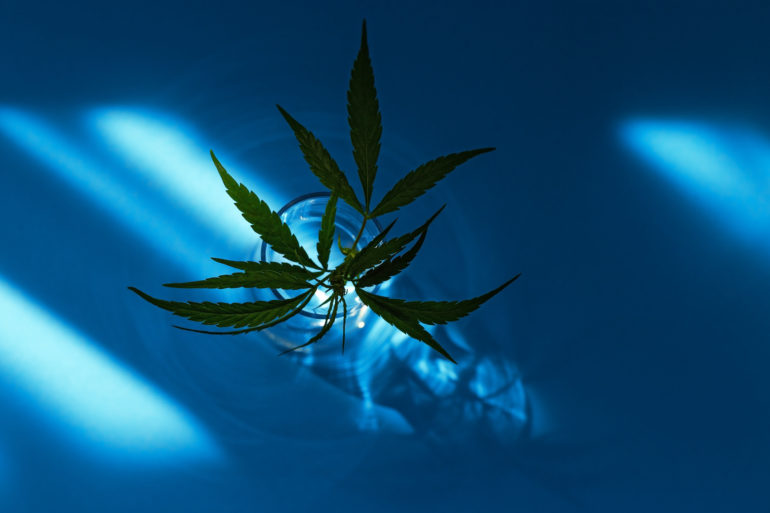Cannabinol (CBN) is a common and weakly-psychoactive cannabinoid you can get from cannabis and hemp. There’s enough CBN in cannabis flower to be extracted into CBN-dominant products. CBN is typically presented to consumers this way, or in myriad ratio combinations with other cannabinoids.
The data overall are limited but the many potential therapeutic uses of CBN include pain relief, reducing inflammation, anticancer, and inducing sleep.
CBN is pleasantly and well-tolerated in small, old studies without significant adverse effects. However, we don’t have robust modern studies to accurately determine CBN’s specific side effects.
What Is Cannabinol (CBN)?
CBN is a “big four” cannabinoid like THC, CBD, and CBG. CBN constitutes between 0.1-1.6% of a cannabis leaf’s weight, increasing as it ages. That doesn’t sound like much, but it’s relatively abundant compared to the other 150 minor cannabinoids.
Intriguingly, CBN is a cannabinoid that cannabis plants don’t directly synthesize. Rather, CBN comes from breaking down (oxidizing) THC with UV light, heat, and air. Even under ideal storage conditions, THC slowly breaks down into CBN, which remains detectable for thousands of years.
CBN is how we can prove THC use in ancient times, since it doesn’t come from anywhere else. Some plants other than Cannabis are capable of producing cannabinoids, but no others can make CBN.
Because of this time stability, CBN was the first isolated cannabinoid in 1886. Afterward, Roger Adams first synthesized CBN in 1940. Since then, we’ve come up with many ways to fully or semisynthesize CBN.
CBN vs. THC: Key Differences
- CBN is a degradation product of THC; both are in cannabis and hemp
- THC is the main psychoactive cannabinoid and CBN is weakly psychoactive
- THC produces stronger sedation than CBN alone, but they enhance each other
CBN vs. CBD: Key Differences
- CBD is more abundant and available than CBN for retail distribution
- CBD is non-impairing at any dose, and CBN may have mild psychoactive effects at high doses
- CBN and THC may be better than CBD for glaucoma
Benefits and Effects
The benefits of CBN haven’t been rigorously tested enough, but so far limited research points to potential therapeutic use for:
- Pain – Including myofascial, fibromyalgia, and TMDs
- Inflammation
- Allergic airway disease
- Antioxidant
- Neuroprotection – Potential for Huntington’s, Alzheimer’s, and Parkinson’s
- Epidermolysis bullosa
- Anticonvulsant
- Anticancer – Inhibits tumor cell growth and resistance proteins in glioma, liver, and breast cancer
- Antibacterial
- Glaucoma – Lowers IOP and normalizes proteins in mice
- Stimulating appetite
- Promotes bone formation
- Sleep – Best with THC
Side Effects
There are very few studies that specifically look at the side effects of CBN. Most are outdated and note that CBN alone doesn’t cause any systemic effects, but in combination with THC, users predictably felt intoxicated.
While not very enlightening, it’s encouraging that people were once hooked up to a CBN IV, turned up to the max dose they could “comfortably tolerate”, and still rated it a “mild and enjoyable” experience. This is the root of thinking that CBN is weakly psychoactive but well-tolerated.
Most CBN studies occurred in the 70s and 80s, so it’s time to follow up on that research because no substance is truly free of side effects.
Dosing
The amount of CBN you take should be based on your goals and individual needs.
To promote CBN for sleep, manufacturers will typically suggest doses of less than 5 mg. This is unlikely to be effective, as limited research has yet to confirm any efficacious dose of CBN for sleep.
However, that doesn’t necessarily mean CBN can’t otherwise be used effectively, such as in high doses or better yet in combination with THC. You should then consider a starting dose of at least 10-20 mg CBN, and keep working your way up by 5-10 mg at a time until desired effects are achieved. Be sure to account for any other cannabinoids present and consider a 1:1 ratio with THC, CBD, CBDA, or CBG to enhance the effects.
Psychotropic Effects
CBN may possibly get you high but this largely depends on the dose, route, and quality of the product. Unfortunately, the psychotropic properties of CBN are still debated and unclear, thanks to outdated and flawed research.
Today, we know that CBN binds to CB1 receptors about 10 times less than THC does. This creates the potential for weak psychotropic effects if taken in high enough doses. Akin to THC, oral CBN may be converted into 11-hydroxy-CBN which may be twice as active.
CBN is generally non-impairing when taken in small-to-moderate doses (under 50 mg), which is usually the case for most people. Some consumers, including study participants, may note a “mild and enjoyable” experience, and also feel high if THC is knowingly or unwittingly present.
Drug Tests
CBN will likely not show up in a drug test if taken by itself as a CBN isolate. However, most CBN products are full-spectrum formulations intended to be more naturally effective. Since hemp products including CBN-rich extracts may contain up to 0.3% THC, therein lies the risk of taking full-spectrum products.
If drug testing is a concern, choose to abstain or use CBN isolate products to minimize the chances of building up detectable THC metabolites in the body. CBN and metabolites aren’t specifically looked for.
Still, even CBD metabolites stand a low chance (1-2%) of cross-reacting. It is possible that CBN, a natural THC derivative, may also share this risk, but that’s yet unconfirmed.
Conclusion
CBN has been slept on for the longest time of any cannabinoid, literally and figuratively.
CBN could be used for a variety of conditions, but its efficacy for insomnia remains to be clearly demonstrated. CBN is often marketed for sleep, but in reality it seems to work best with THC.
References
- Chousidis, I., Chatzimitakos, T., Leonardos, D., Filiou, M. D., Stalikas, C. D., & Leonardos, I. D. (2020). Cannabinol in the spotlight: Toxicometabolomic study and behavioral analysis of zebrafish embryos exposed to the unknown cannabinoid. Chemosphere, 252, 126417. https://doi.org/10.1016/j.chemosphere.2020.126417
- Corroon, J. (2021). Cannabinol and Sleep: Separating Fact from Fiction. Cannabis and Cannabinoid Research, 6(5), 366–371. https://doi.org/10.1089/can.2021.0006
- Farrimond, J. A., Whalley, B. J., & Williams, C. M. (2012). Cannabinol and cannabidiol exert opposing effects on rat feeding patterns. Psychopharmacology, 223(1), 117–129. https://doi.org/10.1007/s00213-012-2697-x
- Geci, M., Scialdone, M., & Tishler, J. (2023). The Dark Side of Cannabidiol: The Unanticipated Social and Clinical Implications of Synthetic Δ8-THC. Cannabis and Cannabinoid Research, 8(2), 270–282. https://doi.org/10.1089/can.2022.0126
- Liang, Z., Soriano-Castell, D., Kepchia, D., Duggan, B. M., Currais, A., Schubert, D., & Maher, P. (2022). Cannabinol inhibits oxytosis/ferroptosis by directly targeting mitochondria independently of cannabinoid receptors. Free Radical Biology and Medicine, 180, 33–51. https://doi.org/10.1016/j.freeradbiomed.2022.01.001
- Maioli, C., Mattoteia, D., Amin, H. I. M., Minassi, A., & Caprioglio, D. (2022). Cannabinol: History, Syntheses, and Biological Profile of the Greatest “Minor” Cannabinoid. Plants, 11(21), 2896. https://doi.org/10.3390/plants11212896
- Passani, A., Posarelli, C., Sframeli, A. T., Perciballi, L., Pellegrini, M., Guidi, G., & Figus, M. (2020). Cannabinoids in Glaucoma Patients: The Never-Ending Story. Journal of Clinical Medicine, 9(12), 3978. https://doi.org/10.3390/jcm9123978
- Russo, E. B. (2011). Taming THC: Potential cannabis synergy and phytocannabinoid-terpenoid entourage effects. British Journal of Pharmacology, 163(7), 1344–1364. https://doi.org/10.1111/j.1476-5381.2011.01238.x
- Somvanshi, R. K., Zou, S., Kadhim, S., Padania, S., Hsu, E., & Kumar, U. (2022). Cannabinol modulates neuroprotection and intraocular pressure: A potential multi-target therapeutic intervention for glaucoma. Biochimica et Biophysica Acta (BBA) – Molecular Basis of Disease, 1868(3), 166325. https://doi.org/10.1016/j.bbadis.2021.166325
- Vikingsson, S., Hart, E. D., Winecker, R. E., Cone, E. J., Kuntz, D. J., Clark, M., Jacques, M., Hayes, E. D., & Flegel, R. R. (2023). Prevalence of ∆8-tetrahydrocannabinol carboxylic acid in workplace drug testing. Journal of Analytical Toxicology, 47(8), 719–725. https://doi.org/10.1093/jat/bkad068
- Walsh, K. B., McKinney, A. E., & Holmes, A. E. (2021). Minor Cannabinoids: Biosynthesis, Molecular Pharmacology and Potential Therapeutic Uses. Frontiers in Pharmacology, 12, 777804. https://doi.org/10.3389/fphar.2021.777804
- Zhong, N., Li, D., Wang, B., Kovalchuk, O., & Kovalchuk, I. (2023). Cannabinol inhibits cell growth and triggers cell cycle arrest and apoptosis in cancer cells. Biocatalysis and Agricultural Biotechnology, 48, 102627. https://doi.org/10.1016/j.bcab.2023.102627

